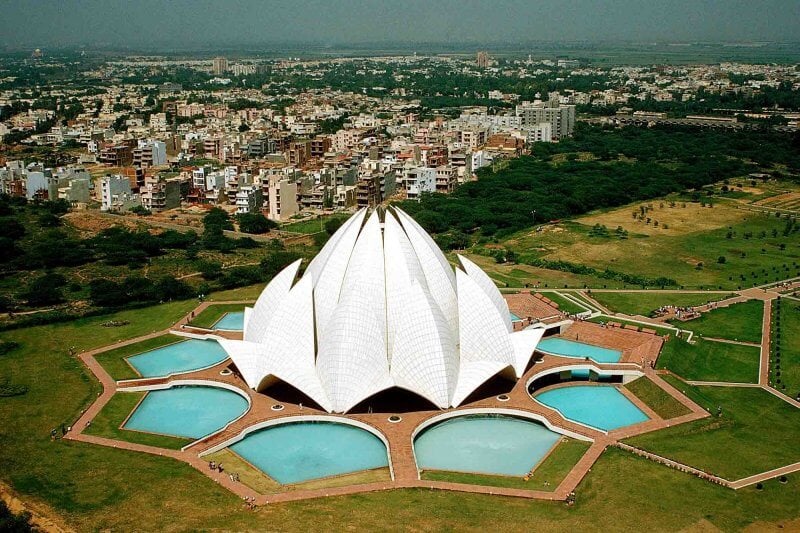The Lotus Temple is one of the main architectural attractions not only in Delhi, but throughout India. Its creators firmly believe that there is only one God on earth, and there are simply no borders between one religion or another.
General information
Lotus Temple, officially known as the Baha’i House of Worship, is located in the village of Bahapur (southeast of Delhi). The huge religious structure, shaped like a half-opened lotus flower, is made of concrete and covered with snow-white Pentelian marble, brought from Mount Pendelikon in Greece.
The temple complex, which includes 9 outdoor pools and a huge garden covering more than 10 hectares, is considered the largest structure of modern times, built according to the canons of Baha’iism. The dimensions of this shrine are really impressive: the height is about 40 m, the area of the main hall is 76 sq. m, and the capacity is 1300 people.
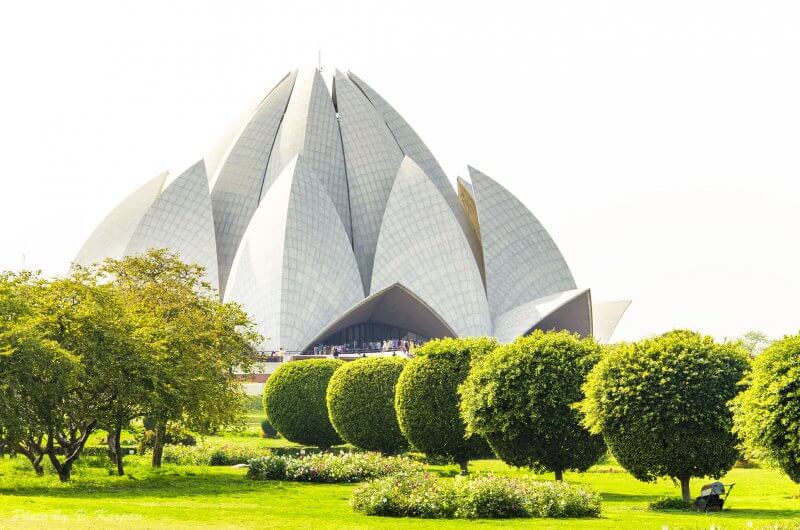
Interestingly, the Baha’i House of Worship is fresh and cool even in the hottest weather. “The reason” for this is a special natural ventilation system used in the construction of ancient temples. According to it, cold air passing through the foundation and water-filled pools warms up in the middle of the building and exits through a small hole in the dome.
There are no regular priests in the White Lotus Temple – their role is performed by regularly rotating volunteers who not only keep order, but also conduct several prayer programs a day. At this time, you can hear a cappella prayers and recitation of Sacred writings belonging to both Baha’i and other faiths within the walls of the House.
The doors of the Lotus Temple are open to representatives of all faiths and nationalities, and the spacious halls in the form of flower petals offer long meditations that take place in complete harmony and peace. Only in the first 10 years since its opening, more than 50 million visitors have visited here, and during the holidays the number of parishioners and ordinary tourists can reach 150 thousand people.
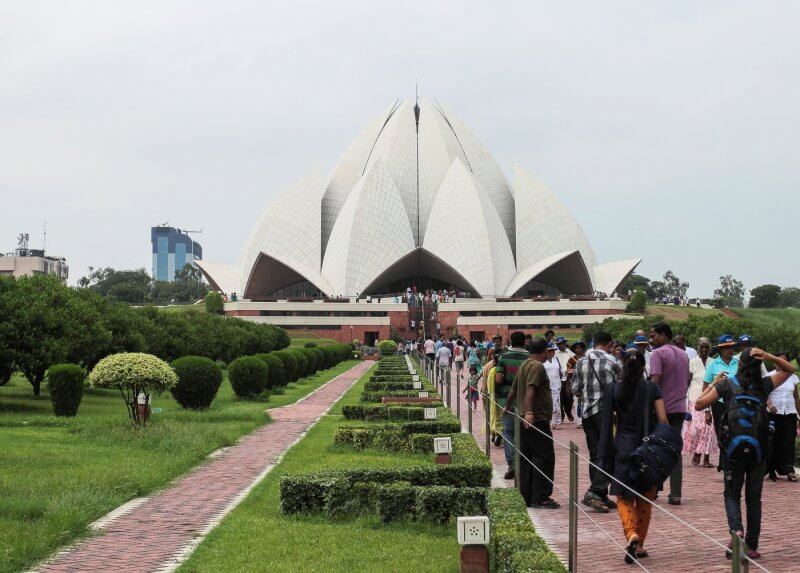
Brief history
The Lotus Temple in Delhi, often compared to the Taj Mahal, was built in 1986 with money raised by representatives of Baha’iism around the world. However, the idea of such a structure arose much earlier – at least 65 years before that. It was then, in 1921, that a young community of Indian co-religionists approached Abdul Baha, the founder of the Baha’i religion, with a proposal to create their own cathedral. Their wish was granted, but the collection of funds necessary for the construction of this structure took almost half a century.
The foundation of the House was laid in 1976 according to the drawings developed by Fariborza Sahba. But before the world saw this unique structure, the Canadian architect had to carry out a truly grandiose work.
Sahba spent about 2 years looking for inspiration in the world’s best architectural structures, until he found it in Sydney’s famous opera House, designed in the style of structural expressionism. It also took the same amount of time to develop a sketch made with the help of modern computer programs. The remaining 6 years were spent on the construction itself, which involved more than 800 people.
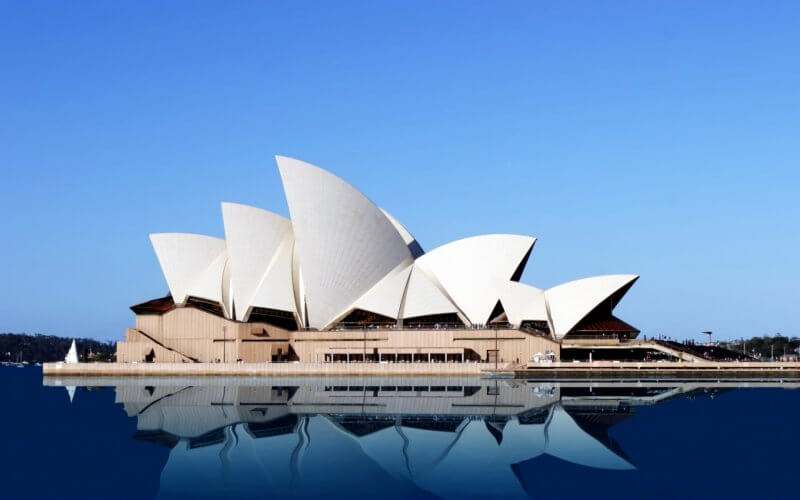
The result of such painstaking work was a unique structure, which is the main temple of the Baha’i religion not only in India, but also in many neighboring countries. It is said that about 100 million rupees were spent on its construction and decoration of the surrounding area. The place for the shrine was also chosen not by chance – in the old days there was a mythical settlement of Baha Pur, closely connected with the history of this faith.
The idea of a council that has no borders between faiths was supported all over the world. To date, the followers of Baha’iism have managed to build 7 more such shrines, scattered in different parts of the world. In addition to Delhi, they are available in Uganda, America, Germany, Panama, Samoa and Australia. The eighth temple, which is currently under construction, is located in Chile (Santiago). True, in religious books and in sacred circles, there are references to Baha’i Houses of Worship built by ancient civilizations. One of them is located in the Crimea, the second-in Egypt, but the way to them is known only to initiates.

The idea of the temple and architecture
Looking at the photo of the Lotus Temple in India, you can see that every detail present in the architecture of this structure has its own high meaning. But first things first.
Lotus shape
The lotus is a divine flower that is considered a symbol of enlightenment, spiritual purity and the pursuit of perfection. Guided by this idea, the chief architect designed 27 huge petals located around the entire circumference of the building. In this simple way, he wanted to show that human life is nothing but the rebirth of the soul and the endless cycle of birth and death.
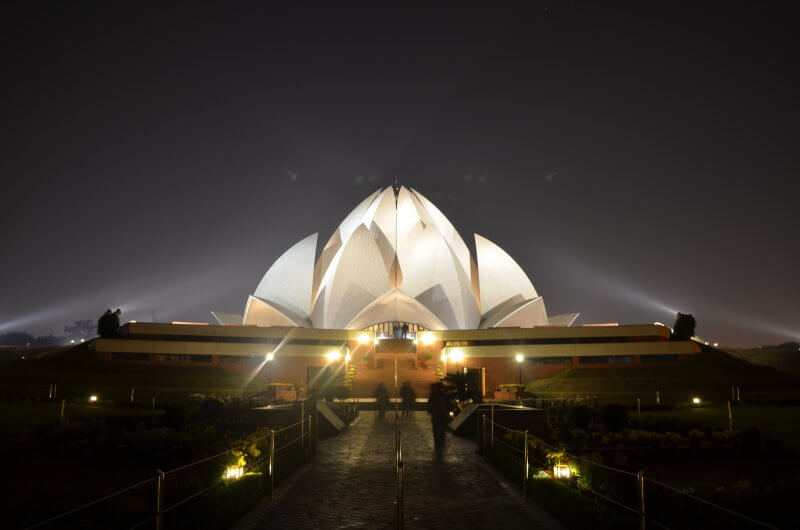
Number 9
The number 9 in Baha’iism is sacred, so it can be found not only in the holy scriptures, but also in the architecture of almost all Baha’i cathedrals. The Lotus Temple is no exception to the rule, and its proportions exactly correspond to the main principles of this faith:
- 27 petals arranged in 3 rows of 9 pieces;
- 9 compartments combined in 3 groups;
- 9 swimming pools located around the perimeter of the temple;
- 9 separate doors leading to the inner hall.
No straight lines
No straight line can be found in the exterior outline of the Baha’i House of Worship. They flow gently along the curves of half-opened snow-white petals, indicating the free flow of thoughts striving for higher matters. It is also worth noting the rounded shape of the sanctuary, symbolizing the movement of life on the Wheel of samsara and reminding people that they came to this world only to get a certain experience.
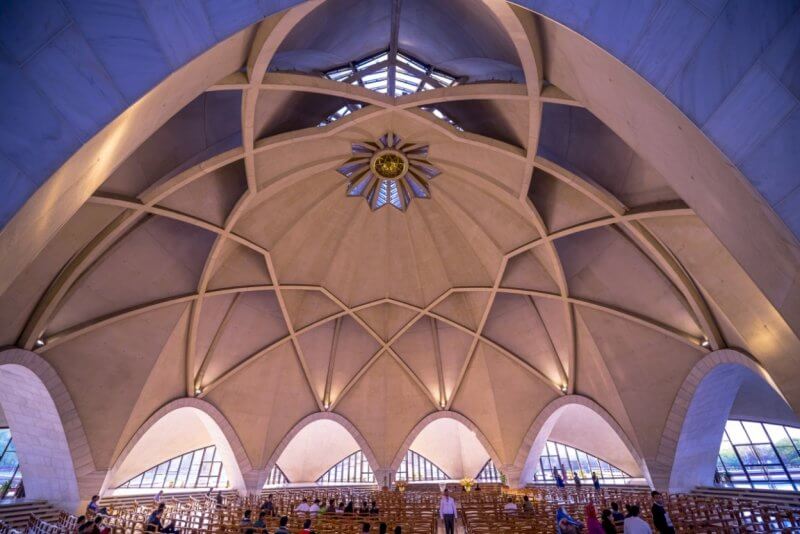
9 meaning-forming doors
The nine doors in the Lotus Temple in Delhi (India) indicate the number of major world religions and grant freedom of worship to anyone who comes within its walls. At the same time, they all lead from the central part of the hall to the nine outer corners, hinting that the abundance of faiths that exist today only leads people away from the direct road to God.
The architect who worked on the creation of the Lotus Temple took into account all aspects and thought out not only the shape of the cathedral, but also its surroundings. It is for this reason that the temple complex was built a few kilometers from the city, so that everyone who comes could at least temporarily forget about the daily worries and hustle and bustle. And along its perimeter there are 9 pools that create the impression that a stone flower actually glides on the water surface.
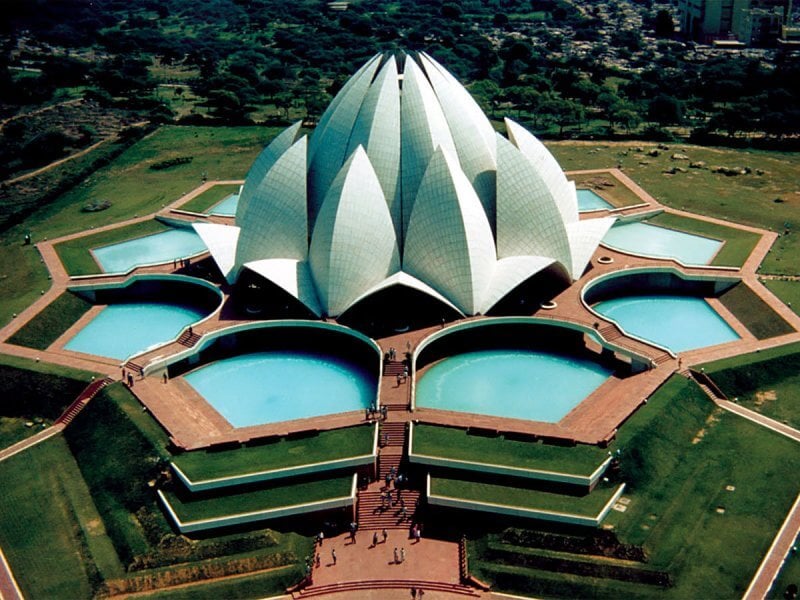
At nightfall, this entire structure is illuminated by powerful LED lights that make it even more realistic. The originality of this structure has not gone unnoticed – it is regularly mentioned in magazine and newspaper articles, as well as awarded with various awards and architectural awards.
What’s inside?
If you look at a photo of the Lotus Temple in New Delhi inside, you will not see any expensive icons, marble statues, altars, or wall paintings – just benches for prayer and a few simple chairs. However, such asceticism is not connected in any way with the lack of money for the arrangement of one of the main attractions of India. The fact is that according to the holy scriptures, Baha’i temples should not contain any decorations that do not have the slightest spiritual value and only distract parishioners from their true purpose.
The only exception is the huge nine-pointed Baha’i sign, made of pure gold and placed directly under the dome of the shrine. If you look closely, you can see the phrase “God is above all” written in Arabic. In addition to the central hall, there are several separate segments dedicated to all world religions. Each of them has a separate gate.
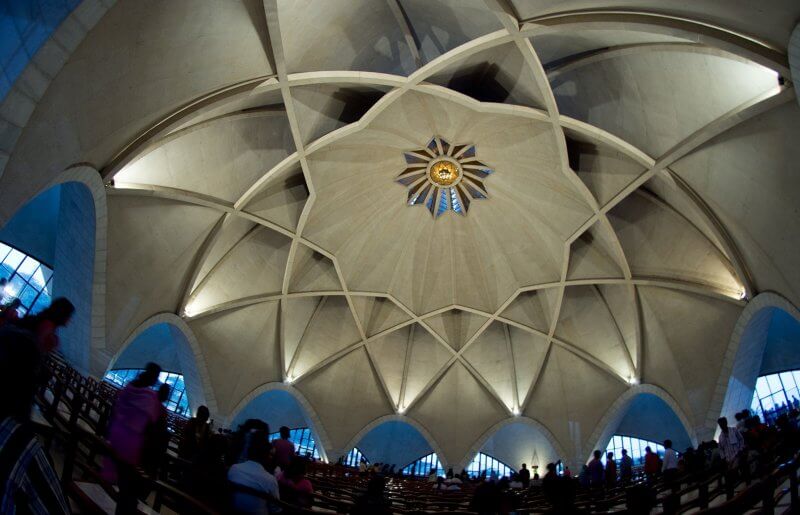
Guided Tours
Free guided tours of the property are available daily. To do this, in front of the entrance to the Lotus Temple in India, there are specially trained employees who gather all the people in groups, explain the rules of behavior to them, and then hand them over to professional guides. To avoid confusion and unrest, people are allowed to enter in portions, but foreign tourists have an advantage over residents of India, so you will not have to languish waiting for your turn.
The duration of the tour is one hour, after which the group is taken out to the courtyard, where it is waiting for a walk in the park. The number of groups allowed inside at the same time depends on the total number of visitors (there can be 1, 2, or 3 of them). At the same time, they try to keep representatives of European countries together, and excursions for them are conducted in English (there is no audio guide, but if you are very lucky, you can find a Russian-speaking guide).
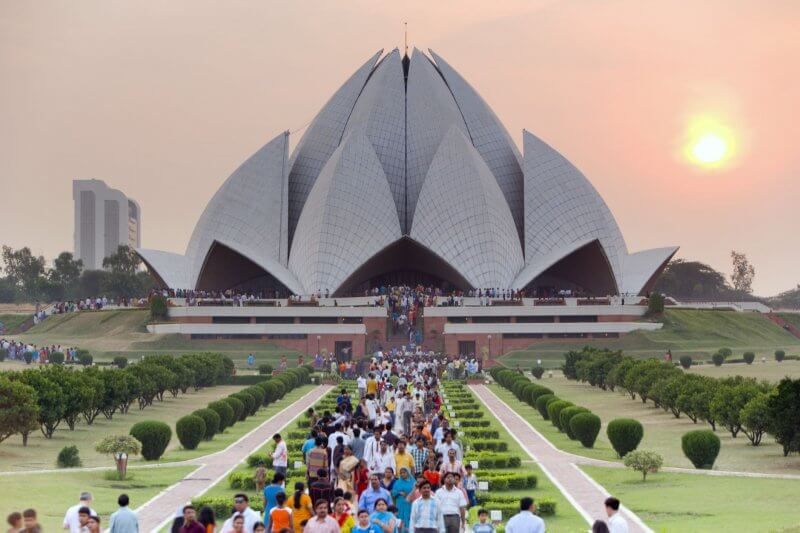
Practical information
The Lotus Temple (New Delhi) is open all year round from Tuesday to Sunday. Opening hours vary depending on the time of year:
- Winter (01.10-31.03): from 09: 00 to 17: 00;
- Summer (01.04-30.09): from 09: 00 to 18: 00.
On Sundays and public holidays, the Prayer Hall is closed until 12 o’clock.
You can find this important Indian landmark at: Near Kalkaji Temple, East of Nehru Place, New Delhi 110019, India. Entrance to the territory is free, but if you wish, you can leave a small donation. For more information, please visit the official website — http://www.bahaihouseofworship.in/
Useful tips
Before you go on an excursion to the Lotus Temple, take note of a few useful tips:
- Before entering the sanctuary, shoes are left in free storage rooms – this condition is mandatory.
- The Baha’i House of Worship should be completely silent – thanks to the unique acoustics, every word you say will be heard by everyone present.
- It is forbidden to use photo and video equipment inside the House, but you can shoot as much as you want outside.
- The best photos of the cathedral are taken in the morning.
- You will have to pass a security check before entering the park. At the same time, not only bags are searched, but also the visitors themselves (there are 2 separate queues for women and men).
- Please note that food and alcoholic beverages are not allowed on the property.
- To make your visit to the Lotus Temple even more exciting, come here during prayer hours(10:00, 12:00, 15:00 and 17: 00).
- The best way to get there is from Nehru Place or Kalkaji Mandir Metro stations. But for those who are not very well versed in the city, it is better to order a taxi.

